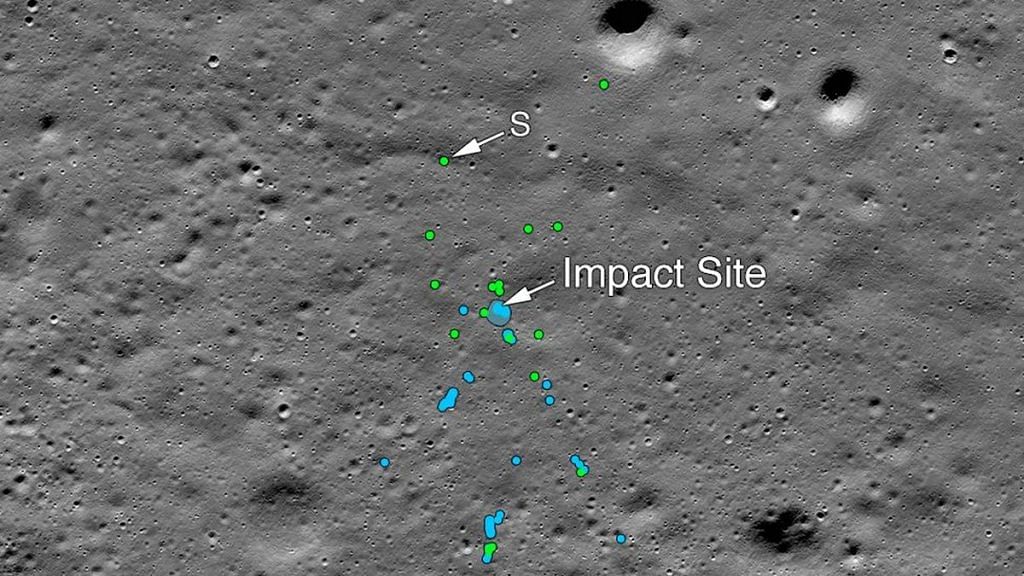Bengaluru: An Indian engineer aided NASA’s Lunar Reconnaissance Orbiter (LRO) team in its discovery of the impact site of Chandrayaan-2’s lander, Vikram.
In a statement issued Tuesday, NASA said a tip from Chennai-based Azure developer Shanmuga Subramanian helped the LRO team identify the location of the lunar lander, which attempted a soft landing on the moon on 7 September.
The LRO team identified the location of Vikram’s impact site by comparing the before and after pictures of the spacecraft’s overhead pass, first taken by NASA on 17 September and released on 26 September.
Subramanian analysed these pictures and emailed the LRO team with his identification of the debris field, the statement said.
Using his tip, the LRO team studied image sequences obtained on 14 October and 11 November, and was able to identify the impact disturbances in the lunar regolith (soil) and pieces of debris from the lander strewn on the surface.
The lander crashed close to the expected site of landing — the impact site’s coordinates are 70.8810°S, 22.7840°E, while the expected landing coordinates were 70.9°S, 22.7°E.
Also read: ISRO plans second attempt at soft landing on Moon for November 2020
‘Calculated from NASA data’
Speaking to ThePrint, Shanmuga Subramanian said after NASA released the first image, he found the expected coordinates on ISRO’s live stream of the attempted soft landing and social news aggregation platform Reddit.
“From ISRO’s live television data, I calculated how far Vikram could have landed from the landing location as each pixel is equal to 1.25m and each square is 1.25km in length in NASA’s image,” Subramanian told ThePrint.
“I decided to search around 2×2 sq km area around the expected landing coordinates and concentrated my efforts north of landing point, as Vikram approached the (designated) area from the North Pole,” he added.
Subramanian posted his findings on micro-blogging site Twitter on 3 October. He also tweeted it to ISRO’s official account, he said.
Is this Vikram lander? (1 km from the landing spot) Lander might have been buried in Lunar sand? @LRO_NASA @NASA @isro #Chandrayaan2 #vikramlanderfound #VikramLander pic.twitter.com/FTj9G6au9x
— Shan (Shanmuga Subramanian) (@Ramanean) October 3, 2019
Subramanian subsequently wrote to NASA. The LRO team acknowledged his email and credited the tip to him in its statement Tuesday.
@NASA has credited me for finding Vikram Lander on Moon's surface#VikramLander #Chandrayaan2@timesofindia @TimesNow @NDTV pic.twitter.com/2LLWq5UFq9
— Shan (Shanmuga Subramanian) (@Ramanean) December 2, 2019
“The debris first located by Shanmuga is about 750 meters northwest of the main crash site and was a single bright pixel identification in that first mosaic (1.3 meter pixels, 84° incidence angle). The November mosaic (image) shows best the impact crater, ray and extensive debris field,” NASA said in its statement.
In its images, the three largest pieces of debris are each about 2×2 pixels and cast a shadow of size one pixel.
After 7 September, when ISRO lost communication with Vikram lander, the Indian space agency’s only official statement said it was still attempting to re-establish communication. However, leaked statements said ISRO discovered the lander in a single piece but tilted.
The Modi government told Parliament only last month that the spacecraft underwent a “hard landing”.
The Chandrayaan-2 orbiter around the moon is still intact and functioning as expected, with an extended lifespan of 7 years. Meanwhile, ISRO is once again eyeing a lunar landing by this time next year.
Also read: Discovery of water on moon: What India’s first Chandrayaan mission achieved a decade ago
